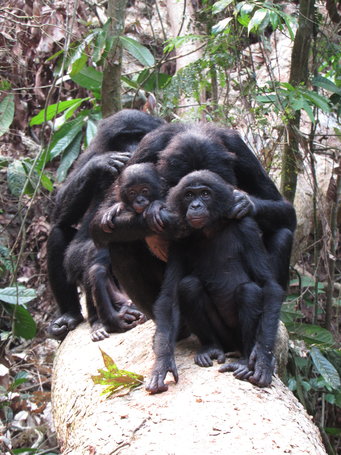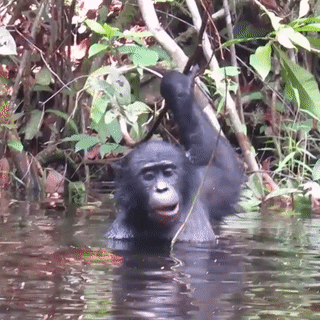Complex Sociality: How Intergroup Encounters and Nutrient Acquisition Shape Bonobo Societies
Imagine a major airport in the middle of the day: while some people are sitting patiently in the waiting areas, others are eating in the food courts or travelling hurriedly through the maze of a polished corridors. It’s a veritable bee hive swarming with staff members, families, groups of friends and solo travelers, all of them interacting on some level as they make decisions about what to do, where to go and whom to socialize with. How does such a complex and co-operative social system evolve? To answer this question, we need to understand how environmental and social conditions influence individual and group decision-making processes.

Complex Sociality
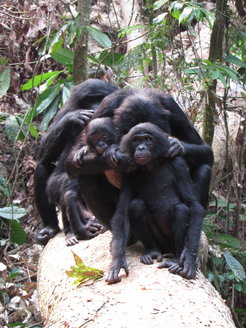
Complex sociality is a term used to describe social systems in which individuals are organized into distinct social units or groups that cooperatively interact with one another. For example, in some species of ants, workers are organized into groups that co-ordinate and carry out specialized tasks within the colony. In other species such as plains zebras and gelada monkeys, individual family units form larger herds or bands that forage and sleep together. By studying complex sociality in non-human animal species, we can gain insights into the evolution of our own complex social system.
The bonobo (Pan paniscus) is a great ape species with a social system that is particularly suited to asking questions about the evolution of complex sociality due to its human-like properties such as tolerance between non-related individuals and flexibility in when and how individuals interact with one another. Primate socioecological theory suggests that social systems are ultimately shaped by how individuals respond to environmental and social conditions. I am studying how acquiring resources such as food, mates and sleep sites shapes the social system of a wild population of bonobos at the LuiKotale field site in the Democratic Republic of Congo, Africa. Here, I follow and collect detailed feeding and behavioral data on adult individuals from two bonobo groups in order to investigate how gaining access to resources influences (1) the frequency and nature of social interactions between social groups; and (2) decision-making and spatial cohesion within groups.
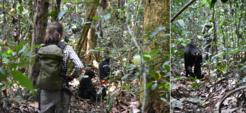
Intergroup Encounters: How often and how tolerant?
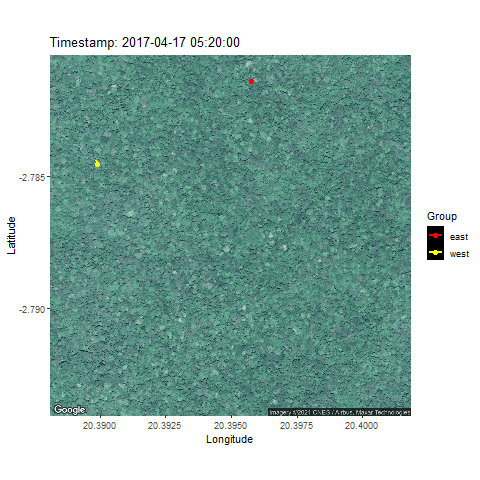
The nature of the relationship between two groups (e.g., tolerant vs. aggressive) can influence each group’s access to important resources like food patches and sleep sites, and this can ultimately shape the social structure of entire animal populations. Tolerant interactions are particularly interesting because tolerance is thought to be necessary for the formation of cooperative relationships between unrelated individuals - something that is fundamental to the formation of social systems like ours. Bonobo groups often exhibit a high degree of tolerance towards one another, with individuals from different groups observed grooming, playing, mating and even sharing food. This makes the bonobo social system a good model for studying factors that facilitate intergroup tolerance. I am interested in how environmental and social factors influence how often two groups of bonobos at LuiKotale encounter one another and how tolerant these encounters are. Here, these two groups exhibit highly flexible behavior during encounters: while some interactions are incredibly tolerant (e.g., meat sharing), others are incredibly aggressive, resulting in notable injuries to some participants. Such flexibility provides the perfect opportunity to investigate how environmental and social conditions influence how often bonobo intergroup encounters occur and how tolerant they are.
Nutrient Acquisition: What About Minerals?
Groups of bonobos may encounter one another when moving through the landscape in search of specific nutrients that are scarcely distributed. Minerals in particular tend to be highly localized in specific patches and so groups may be more likely to encounter one another at these hotspots and compete for access to them. Dealing with intergroup competition for food resources is just one challenge faced by group-living individuals in their quest to obtain sufficient nutrients to survive and reproduce. When the types and quantities of food items vary in space and time, individuals and groups are challenged to locate resources. In addition, individuals may have to compromise when they face conflicts with other group members about when, where and what to eat. So, how do group-living animals like bonobos acquire enough nutrients when environmental and social conditions are so variable and complex? When investigating this question, previous research in the field of primate nutritional ecology has focused on the acquisition of energy (i.e., calories) and specific macro-nutrients like carbohydrates, fats and proteins. Considerably less attention has been paid to how minerals (e.g., calcium, potassium, iron, etc.) influence individual and group foraging strategies even though minerals are critical to primate health and have been shown to influence their movement and habitat use.

I am interested how bonobos acquire sufficient minerals and how the decisions they make to acquire minerals influence their movement and social interactions. To investigate these questions, I collect several types of data while following individual bonobos on foot through the tropical forest. These include feeding intake rates, a measure of how much food an individual consumes per minute; and samples of plants and animal tissue, which are opportunistically collected from bonobo prey items such as forest antelopes and monkeys. Samples are then analyzed by the Nutritional Physiology Laboratory at the Leibniz Institute for Zoo and Wildlife Research in order to estimate their mineral content. I also use a state-space modeling approach called nutritional geometry to investigate how individuals regulate the intake of different minerals over time. Doing so will provide insight into which nutrients individuals prioritize as food availability changes.
The Iodine Puzzle
Chances are, you have heard about the importance of minerals like calcium and iron to your health. But have you heard much about iodine beyond the words written on a box of iodized salt? Likely not. So, what is iodine and why should you care? Iodine is a trace mineral required for the synthesis of thyroid hormones, which help regulate organ development, growth, reproduction and metabolism in all vertebrate species. As these hormones are essential for proper human brain development, iodine has been identified as one of the so-called brain-selective nutrients that influenced human brain evolution. Furthermore, since iodine is primarily concentrated in marine environments and hence marine-based food resources (e.g., seaweed, fish and shellfish), coastal habitats have received considerable attention as locations that triggered the expansion of the human brain.
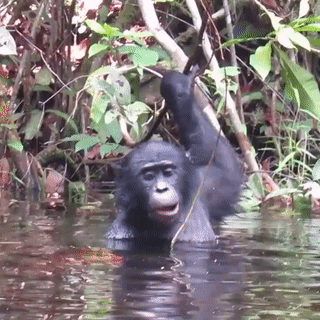
In humans, iodine deficiency disorders (IDDs) are considered a major public health problem due to their negative effects on human health and, consequently, social and economic development (see report by the World Health Organization). One of the most obvious symptoms is a goiter, but other symptoms include fatigue, dry skin, feeling cold all of the time and trouble learning and concentrating. In natural animal populations, however, symptoms of iodine deficiency are rare, even where animal populations live in the same environments as IDD-prone human populations. Perhaps one of the most striking examples of this contrast exists between humans and wild bonobos in the Congo Basin, Africa. Prior to iodized salt supplementation here, human populations-including some active hunter-gather populations - suffered from high incidences of IDDs. Yet, bonobos, which share over 98% of their genetic material with humans, rarely display symptoms of iodine deficiency despite living in the same tropical environment. What accounts for this difference? Do bonobos possess some behavioral, dietary and/or genetic advantage over humans or do they simply require less iodine to meet their biological needs?
My research aims to explore these questions by specifically focusing on iodine intake by adult bonobos at the LuiKotale field site. Specifically, I will quantify how the iodine content of bonobo food items changes over time; and how much iodine individual bonobos consume on a daily basis in order to estimate how much iodine wild bonobos require to avoid iodine deficiency. I will also investigate food selection by bonobos in aquatic, swampy and herb-dominated food patches to assess whether these habitat types are important sources of iodine for bonobos. Through my research, I hope to provide insight into whether and how humans immigrating inland from iodine-rich marine environments could have satisfied their dietary need for iodine.
Further reading & Cited articles
The LuiKotale Bonobo Project: Find out more about the long-running field site where I conduct my research!
The Importance of Intergroup Tolerance
Johnson, C. A., Raubenheimer, D., Rothman, J. M., Clarke, D., & Swedell, L. (2013). 30 Days in the Life: Daily Nutrient Balancing in a Wild Chacma Baboon. PLoS ONE, 8(7), e70383. (read about nutritional geometry in action!)
Acknowledgements
As with many scientific research projects, my work would not be possible without the support of an amazing research team. This team includes (i) my academic supervisors, Dr. Barbara Fruth, Dr. Meg Crofoot, Dr. Jessica Rothman and Dr. Shauhin Alavi; (ii) my project assistant, Nicolás Corredor-Ospina; and (iii) all of the incredible international and local research assistants from the LuiKotale Bonobo Project that make living and working in the middle of the jungle such a pleasure. And, of course, none of this work could happen without financial, logistical and technical support from the project’s collaborators (listed below). Thank-you!

Written by Kathrine Stewart, Department for the Ecology of Animal Societies

